In the MUSEUM JOURNAL for December, 1913, an article appeared, in which a large number of vases were published, that had been put together from fragments, which had been found at Orvieto, and brought to the Museum through the generosity of John Wanamaker.
But even after the vases published in that article had been mended, a large number of fragments were left, and it was deemed opportune to attempt the restoration of other vases this autumn, and see if anything could be made of the potsherds remaining. The results have been happy, and some of these vases will soon be put on view.
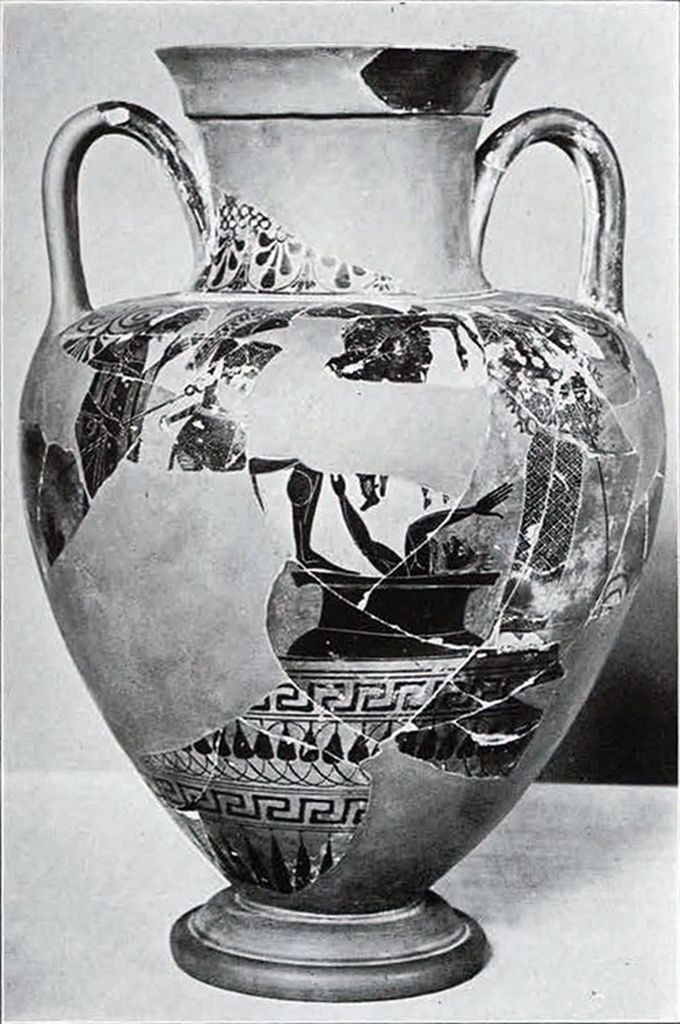
Museum Object Number: MS4860
1. The first vase to be described (Figs. 34 and 35), an Attic black-figured amphora, had already been published in part in the article already referred to (p. 159, Fig. 137), where attention was called to the principal subject, that of Herakles and the Erymanthian Boar. This labor of Herakles is one of the most popular of his exploits among Greek vase painters. In the spring of 1913, while preparing a dissertation for the degree of Ph.D. at Harvard University, the writer came across references to seventy-one vases which show this subject, and since then he has either seen, or been referred to, a great many more. These vases can be divided into five classes, according to the way in which they treat the subject. In one, Herakles attacks the boar with his club, or another weapon; in the second class, he wrestles with the boar, very much as he is represented wrestling with the Nemean Lion; in the third, he is either engaged in lifting or carrying the ferocious animal; in the fourth, he brings the boar to Eurystheus; while the fifth group are “doubtful vases” which either cannot be assigned to any of the preceding types, or may not refer to this subject at all, but which have been interpreted as representations of this labor by various scholars. Of these, the fourth class is by all odds the most common, including thirty-six of the seventy-one vases collected in 1913, or over half of the whole. It also has the handsomest, latest, and most important examples.
It will be seen that this amphora belongs to this fourth class. It is needless here to give a complete list of all Erymanthian Boar vases, but it will suffice to say that this vase shows the subject in the normal way. Eurystheus, the uncle of Herakles, at whose bidding the labors were performed, is so frightened at the sight of the hero bringing him the boar in obedience to his command, that in his fear he has tried to hide himself in a huge jar, or pithos, that is half buried in the ground. Herakles stands over the jar, apparently in the act of hurling the boar on the head of his uncle. He has set one foot on the rim, and braced himself to give force to the throw. Eurystheus, in the jar, holds up his hands in supplication. On the left side of the central group is Hermes; on the right, Athena, both looking on in a purely impersonal way. These two divinities are also the onlookers on a black-figured amphora in the Louvre in Paris, No. F 59, and on a red-figured stamnos, or amphora with side handles, in the museum of Chiusi in Italy; but ordinarily the spectators are Athena and Iolaos, the nephew and constant companion of Herakles.
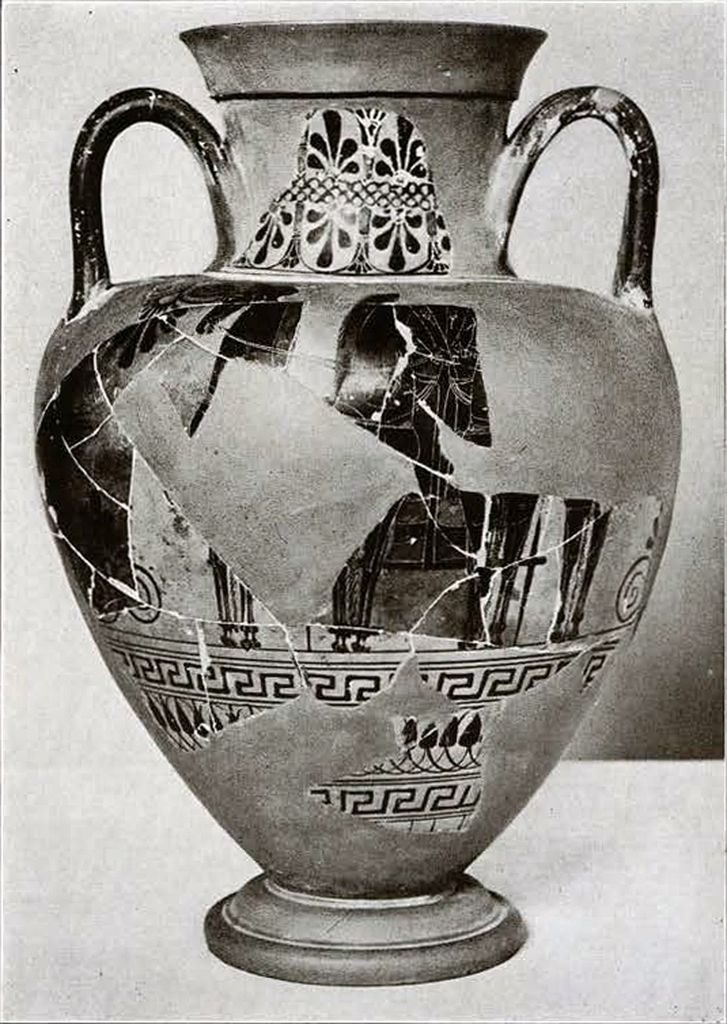
Museum Object Number: MS4860
The reverse of this vase shows a quadriga, or four-horse chariot, seen from the front, which is a common design in this period. The vase dates from the period around 530 B.C.
2. Perhaps the most tantalizing of all the vases restored is the black-figured hydria, or water jar, next shown (Fig. 36). Practically the whole of the undecorated part of the vase exists in fragments, but very little of the panel on which the main design was painted, and almost none of the shoulder. Of the panel, however, enough has been preserved to show that it was a chariot scene. At the horses’ heads stands a figure in a short chlamys, or cloak, and with high, winged boots. This figure is undoubtedly Hermes, the messenger of the gods. Half way between the horses’ heads and the chariot, and back of the horses, is another figure, closely draped, of whom part of the head is preserved (he is the only figure of whom any of the head remains) as well as the legs and feet. This is probably to be regarded as Dionysos. Another figure, of whom only the feet and legs are left, stands by the chariot. No clue is given as to who was in the chariot itself; but from a glance at the two figures that it is possible to identify, it is very probable that they were Athena and Herakles. At the foot of the panel is a frieze of panthers and goats, treated in a very conventional manner.
3. A black-figured krater, or mixing-bowl, with column handles (Figs. 37, 38). This shape is sometimes called a kelebe. It is very probable, on grounds of technique, that this vase is the earliest of those here described. Both the style and the subjects represented are much more archaic than those on the amphora or the hydria. Very few fragments exist of this vase, but enough to give the shape, and show the designs. On the obverse is represented a scene of combat. A chariot is shown facing to right. Although most of the bottom of this painting is preserved, only the hind legs of the horses are shown on the ground. This shows that they were drawn rearing, which is very unusual. A close examination, indeed, of what is left of the design at the right reveals three or four hoofs in the air, belonging to the rearing horses, of which nothing else but the hind legs remain. On the ground is a fallen warrior, whom the horses may be thought of as pawing; while from the right, one of his comrades advances to attack the chariot. In the chariot is a warrior, while an enemy on foot appears to be attacking him from the rear. All wear greaves, which are rendered in purple. Of none of them except the fallen one are the heads preserved.
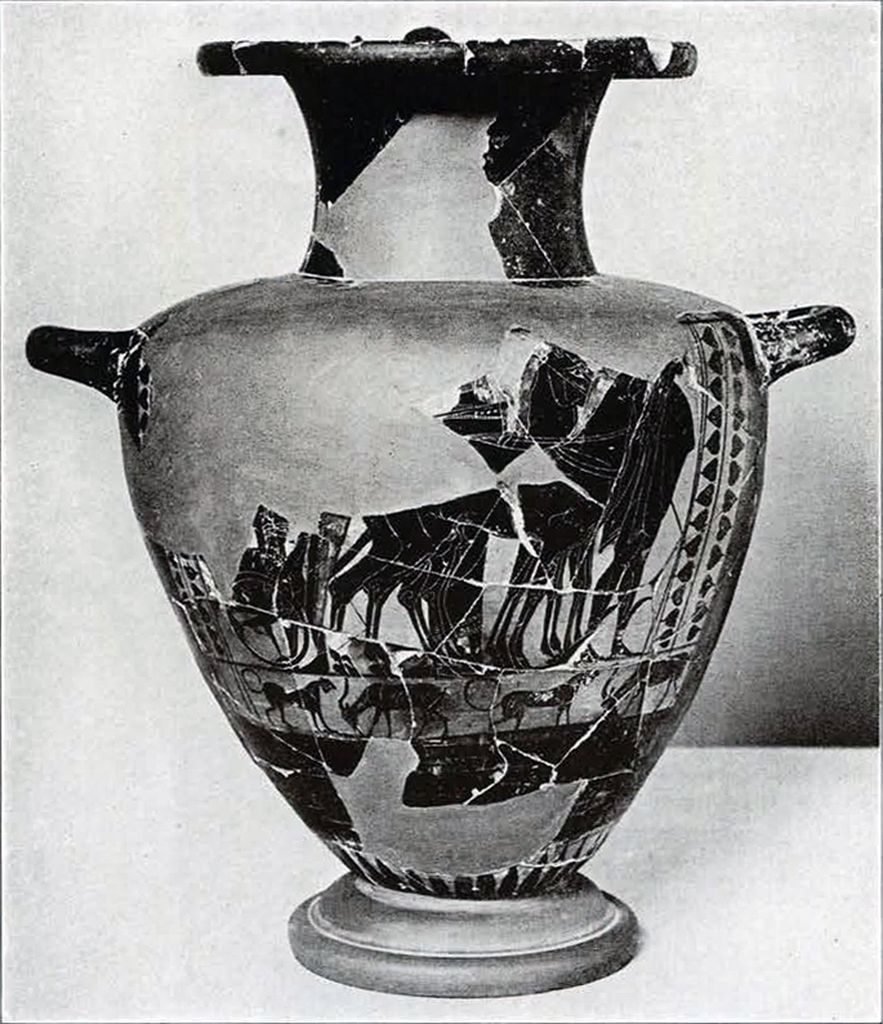
Museum Object Number: MS4853
The reverse of this vase has a decoration of animals, a lion attacking a bull being the central figures. Very little of this side is left. The subject of a lion attacking a bull is one of the very common themes of archaic Greek art. It is found in one of the pediment sculptures of the old temple of Athena on the Acropolis at Athens which is now on view in the Acropolis Museum, and frequently occurs on vases, the famous Francois vase in Florence being perhaps the best known example, where a group almost identical with the one shown here is represented.
4. A black-figured oenochoe, or pitcher (Fig. 39). This vase may be Chalcidian rather than Attic, and, if it is to be regarded as Attic, shows marked Chalcidian influence. On the vase, Hermes is represented, facing two warriors with helmets, round shields, and greaves. Between these two warriors flies a bird. At the right is a draped, bearded man, carrying a spear. The incised work of the crests of the helmets is particularly delicate and fine.
5. A drinking cup without handles, but with a most dainty design of a bird in black, on a small medallion in the center of the interior (Fig. 40). There is no other decoration. With this cup may be grouped five other smaller ones, of varying sizes, undecorated, but nearly entirely preserved.
6. The best vase to be mended is a red-figured kylix, or drinking cup, of the “late severe” or “early fine” style, 460-450 B.C. (Fig. 41). These kylikes represent the finest work of the Greek vase painters, who in their pride often affix their names to the vase, with the formula, “— made it, ” or “— painted it, ” the verb in the former instance being εποίησεν, and meaning that the man was the owner of the establishment that produced the vase, in the latter case, εγραψεν, and meaning that the man who signs is the actual artist. By means of these signatures it is possible to assign certain vases with no signatures to their proper ateliers, as can very readily be seen. This cup is unsigned; but in delicacy of design, and in daintiness of execution it is worthy of the signature of its producer.
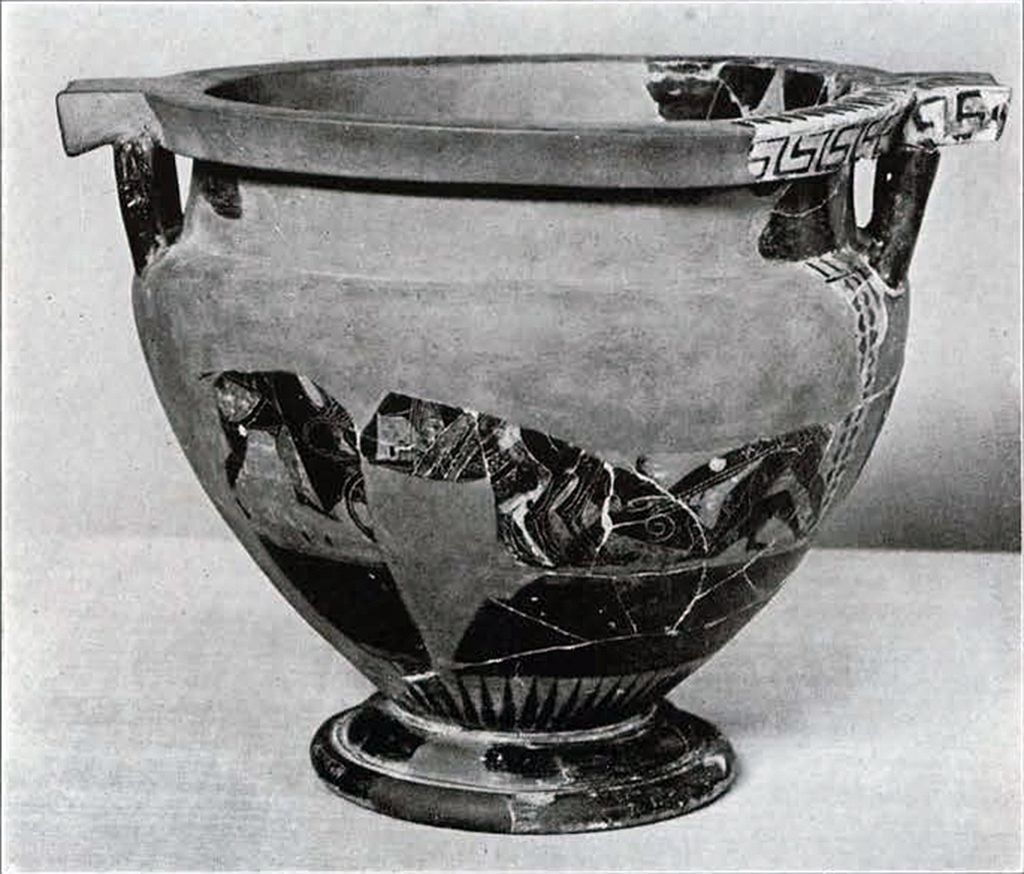
Museum Object Number: MS4876
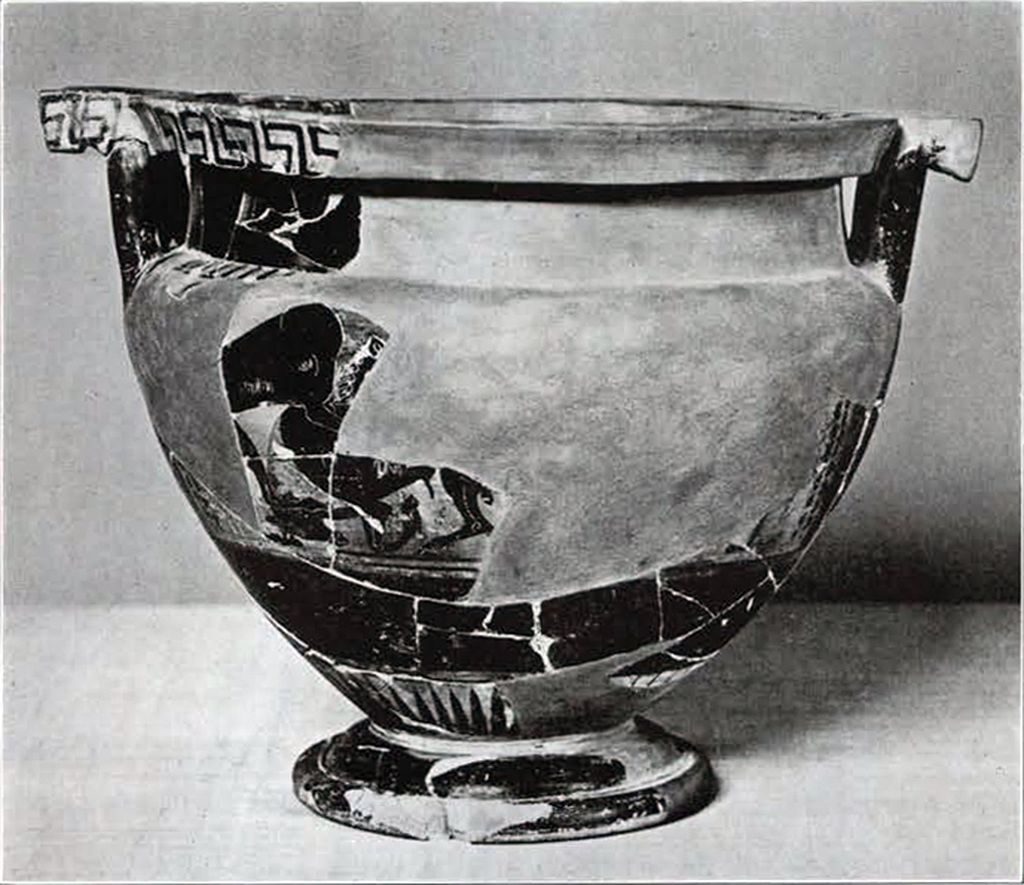
Museum Object Number:MS4876
The study of Greek vases has been greatly advanced in this generation by the work of Hartwig and Furtwängler, who were the pioneers in the difficult work of attributing vases to their makers, and who discovered several new painters, whose names, unfortunately, are unknown, but of whom a number of vases exist, obviously by one hand, and not by the hand of any painter whose name we do know. This work has been most successfully continued by the English scholar, Mr. J. D. Beazley, who has brought to the careful study of Attic red-figured vases an acuteness of perception amounting to genius. Mr. Beazley, through an unequaled knowledge of the museums of Europe and the United States, has been able to bring together no less than sixty new “masters” of the red-figured technique, and to give lists of vases by their hands. He has also added materially to the lists of vases by painters previously known or identified.
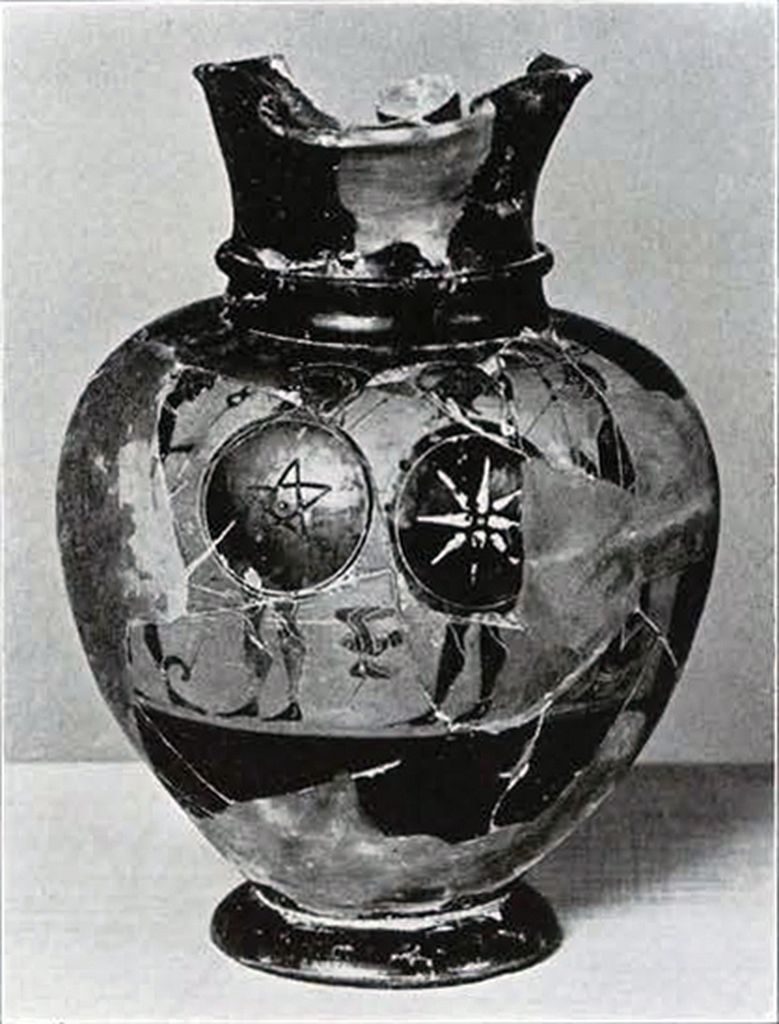
All of the work of Hartwig, Furtwängler, Pottier, Beazley, and other authorities on the assignment of Greek vases to their proper masters has been brought into convenient form, in two volumes, by Dr. Joseph Clark Hoppin, himself a distinguished student in this field, and made easily accessible to the investigator. Dr. Hoppin is well known in Philadelphia, as for many years, and again during the late war, he held the chair of archaeology at Bryn Mawr College. The writer would like here to express his gratitude to Dr. Hoppin for this most valuable work.
It is, therefore, not impossible to attribute the kylix under discussion to its maker. The process is much as we should use in attributing an unsigned Italian canvas to its painter. First we look at the drawing in a general way, to see in what period of the Attic red-figured ware it belongs. We then, having found this period, examine carefully the work of the masters of the period, and see which one it most closely resembles.
From the preliminary examination, we find that our cup belongs at the end of the “severe” or the beginning of the “free” or “fine” style of the Attic red-figured technique. This we can tell by the way the eyes of the figures are drawn, an increased freedom of rendering, and other hints of style. This would put the vase in the decade between 460 and 450 B.C.
The problem now becomes more exacting—to attempt to identify the painter. Each of the artists specified by Beazley or Hoppin as having worked in this period is passed in review, and a comparison made between drawings or photographs of vases by his hand with the cup we are trying to identify. Sometimes actual specimens in the collection in the Museum may be used for purposes of comparison.
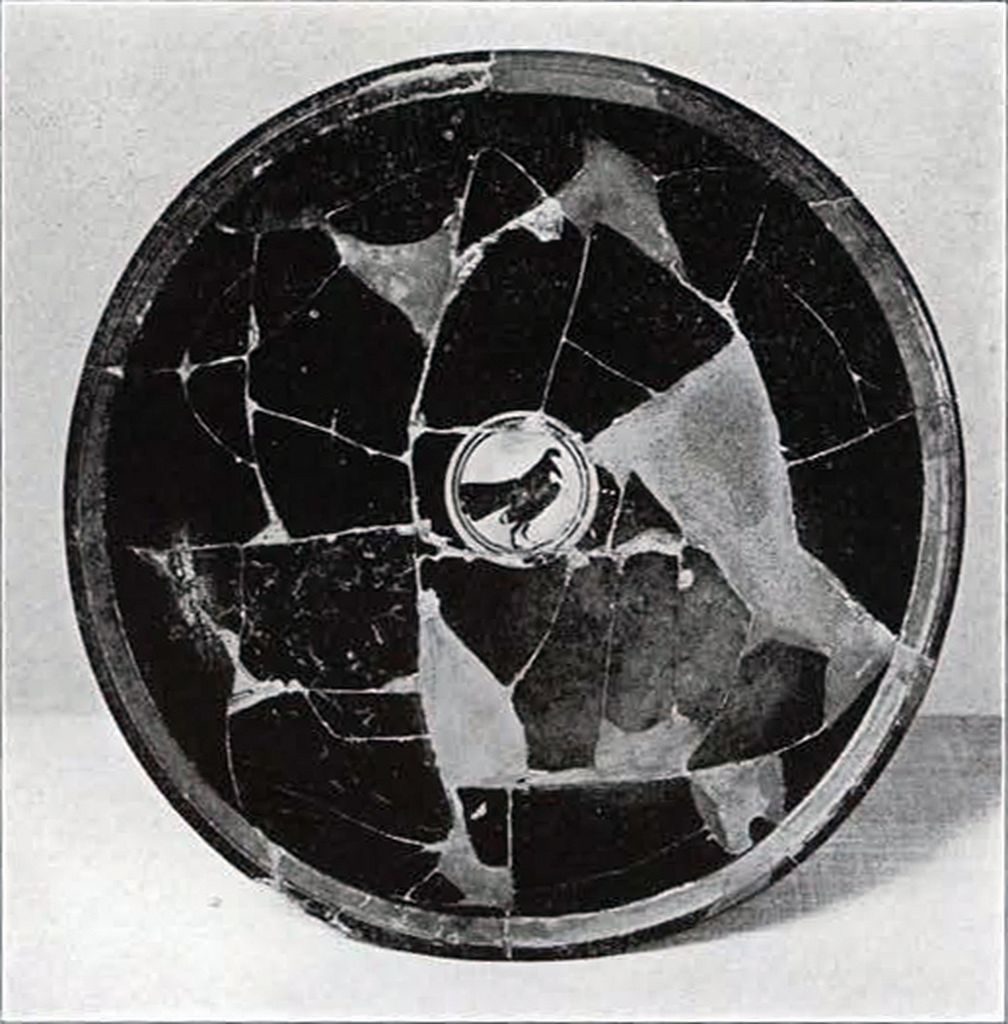
Museum Object Number: MS5669
The opinion of the writer is that this vase is the work of a man first identified by Furtwängler, and called by him, “the Penthesilea Master,” from his principal work, which is a picture of Achilles slaying the Amazon queen Penthesilea, on the interior of a kylix in the Pinakothek in Munich. This painter was very prolific, and very uneven in his work. No less than fifty-two vases in different museums and collections have been assigned to his hand, by various scholars, some of which are among the most magnificent specimens known, while others are drawn with crudity, and childish carelessness. Often the same kylix will show the interior beautifully drawn, while the exterior is execrable.
In studying the Penthesilea master, the writer was aided by the fact that four kylikes in the Museum’s collection had already been attributed without dispute to his hand. There are also kylikes by him at the Academy of Natural Sciences and at Bryn Mawr College, and a kalpis, or small water-jar, in the collection at Memorial Hall. This gives the student of his style a wealth of material in Philadelphia for study and comparison.
This kylix, which has been rescued from fragments, represents one of the average works, perhaps even a little above the average, of the Penthesilea painter. The drawing is neither absolutely careless, nor is it at all magnificent: it is, indeed, one of which no vase painter need feel ashamed, but it has little spontaneity or originality of conception. It is merely a good piece of routine work from the master’s hand. The scenes are the commonplace ones of ladies at their toilet, rendered, however, with much daintiness and sympathy.
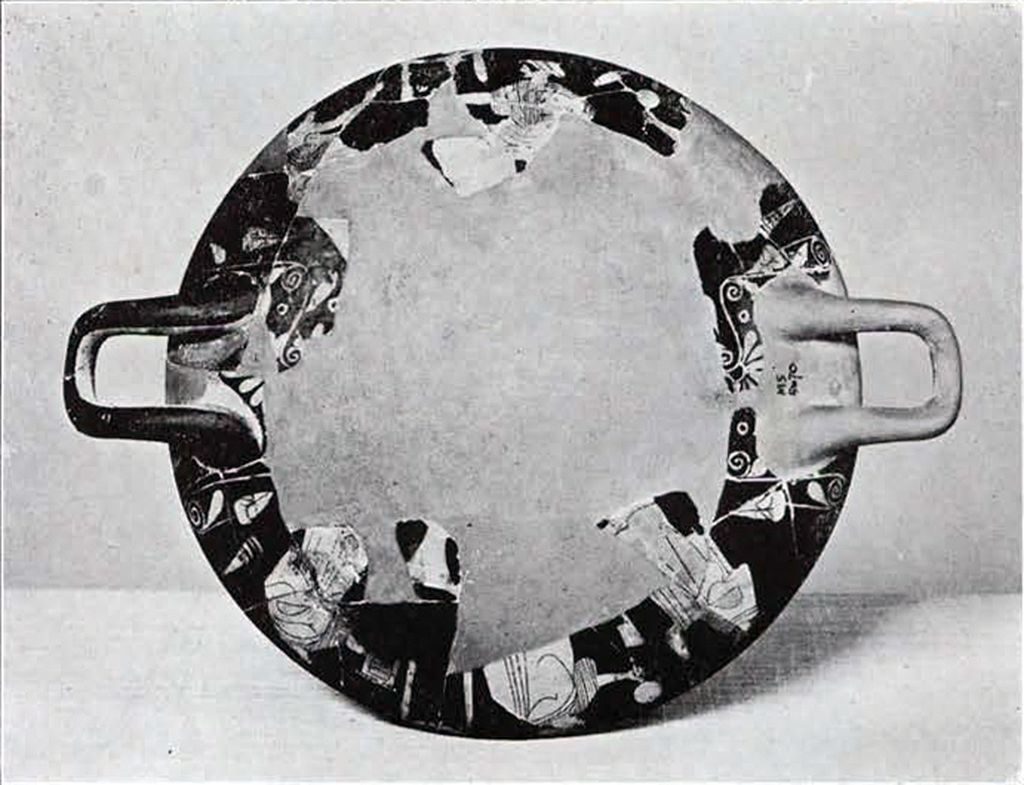
Museum Object Number: MS5670
7. Last of all, comes a vase that is not from Attica, but from Southern Italy (Fig. 42). It has been restored as a stamnos, with a short neck, but it may have been a hydria or kalpis, for carrying water. It is decorated with a single frieze of satyrs, Maenads, and centaurs. The flesh of the female figures is in white, the satyrs sit on panther skins rendered in white, and the horse part of the one centaur preserved is of that color. The handles are molded in the form of serpents. One of these handles has been restored.
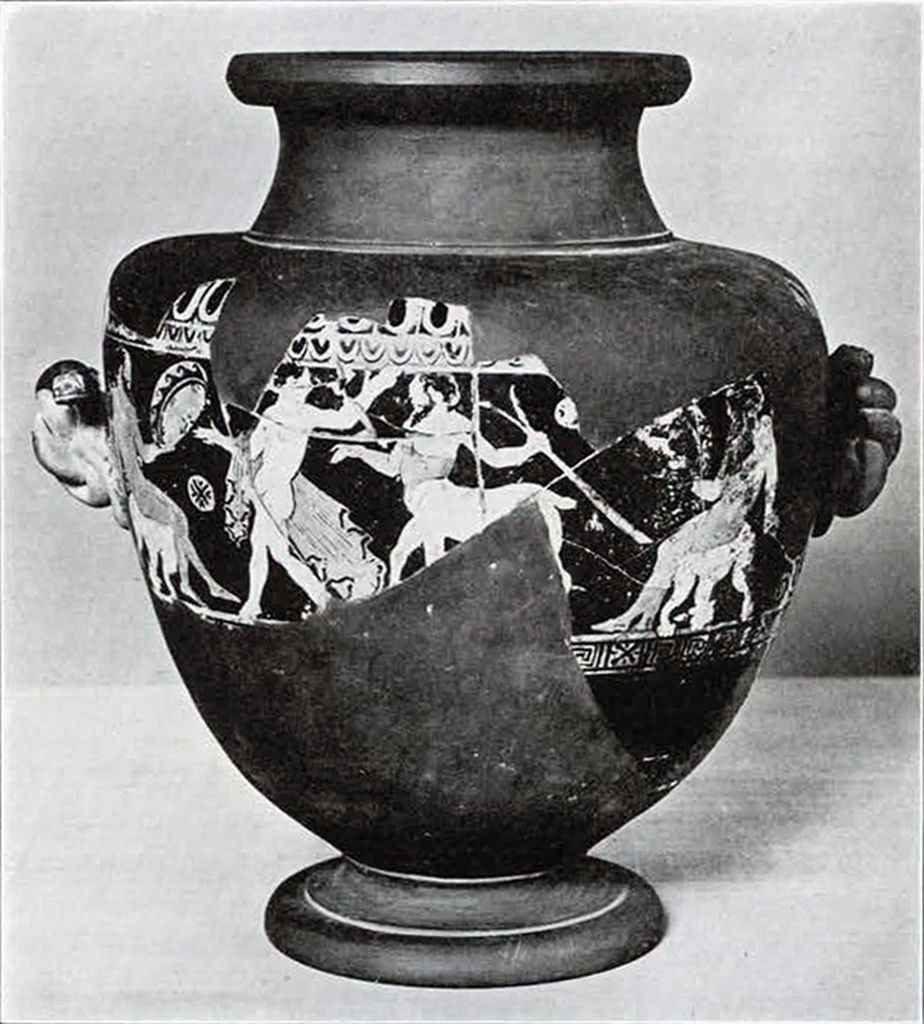
Museum Object Number: MS4854A
Four techniques exist side by side among the Greek vases of Southern Italy: the so-called “Paestum style,” the Apulian, the Campanian, and the Lucanian. It is hard to tell whether the vase in question is Apulian or Campanian, but it is one of the two techniques. Personally, the writer is inclined to believe that it is Campanian, on account of the large amount of polychromy, which is a characteristic of the Campanian ware; for, besides the abundant use of white, red is also found for certain details. Apulian vases, however, are also apt to have a good deal of polychrome decoration; and it is an admittedly hard matter often to distinguish Apulian from Campanian vases. If, however, this vase is to be considered as Campanian, it assumes a good deal of importance in the Museum’s collection; for it is the only specimen of that ware in our possession, our other South Italian vases being Apulian, which is by far the most common of the four techniques.
The mending and putting together of these fragments, has resulted, as we have seen, in the bringing to light of a number of interesting specimens to the prominence that they deserve. They are a distinct addition to the collections of the Mediterranean Section.
S.B.L

